From
my recent diary
2024
Mainly, I use
the following materials since the end of October, 2018.
Telescope: D: 45.5cm f: 2037mm
Dobsomian (Newtonian reflector)
Eyepiece: and magnification:
Ethos 21 mm, apparent FOV 100 deg. 97x, actual FOV 1.0 deg.
or
Night Vison ACT PVS-14 Photonis
4G INTENS 1800 Auto gate P45 WP
Lavendura 63mm, apparent FOV 45 deg. with Paracorr, x37,
actual FOV 1.2 deg.
Sunday, November 23
There finally have been many days with clear skies this month, and
this was the sixth comet hunting session this month. I drew a sketch of
C/2025 K1 ATLAS yesterday. The comet had an impressive shape with a long
tail relative to the coma diameter. Astrophotographers revealed the
nucleus split into three fragments. I tried to observe it yesterday, but
could not due to poor seeing. I challenged again today using at 582x
magnification as seeing was better than that of yesterday. I noticed
elongated nucleus but failed to resolve the split nuclei.
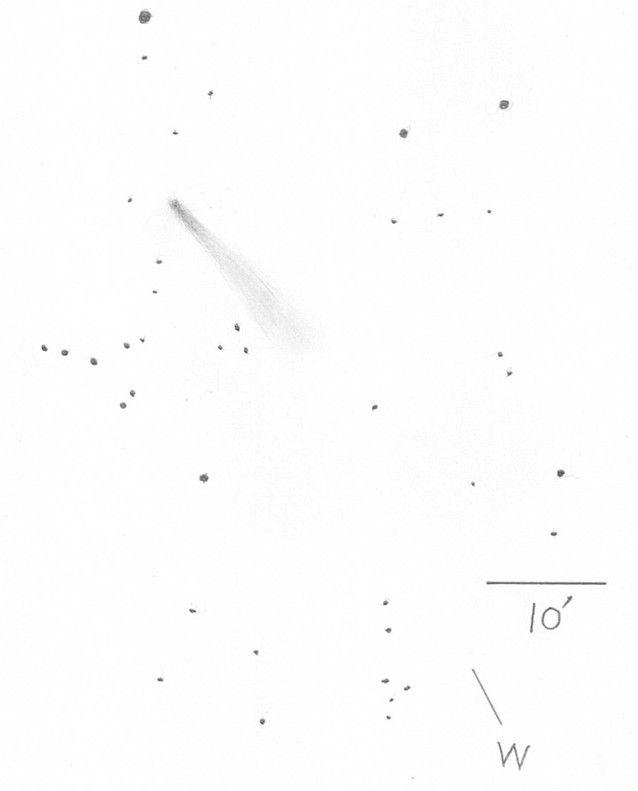
|

|
C/2025 K1 ATLAS Nov. 22 2025 4:25-4:30 JST (21.809-21.813
UT). 46 áp, 97x, diameter 0.7Āf, mag 10, DC=7, tail length 17Āf.
3I ATLAS was in the constellation of Virgo with the magnitude of 10th. The
comet was at an altitude of 19.5Āč at 4:16am local time where I started the
comet searching session. The eyepiece used was Ethos 21 mm at 97x
magnification. First, I trained my telescope at the comet and then pointed
it to an altitude of around 30Āč from where I swept the sky moving the
telescope downward as I usually do. When the field of view (FOV) reaches
the horizon, I shift the FOV slightly horizontally, and repeat sweeping
downward from the altitude of some 30Āč.
Shortly after the start of the session, ninth magnitude galaxy, NGC4697,
appeared in the FOV. Then moved down the telescope toward the horizon,
Spica shined in the FOV that rose 3Āč above the horizon. I identified 29
galaxies in total during the session. I note two particularly impressive
objects. First, M61. At a glance I saw a spiral structure and I was
overcome by the urge to keep watching forever. I would like to closer look
at it at high magnification someday. Second, six galaxies, NGC4270, 4273,
4281, 4268, 4264 and 4261, entered in the same FOV. As I use a digital
setting circle (Nexus DSC) in conjunction with a digital map (SkySafari 7
Pro), it is relatively easy to identify numerous galaxies. Having said so,
it is a significant task to check dozens of galaxies during a comet
hunting session. Until about ten years ago, I used the digital setting
circles with printed map, which required much more effort than the current
method. In the era when the digital setting circle was unavailable, it was
more difficult to identify a single comet-like object.
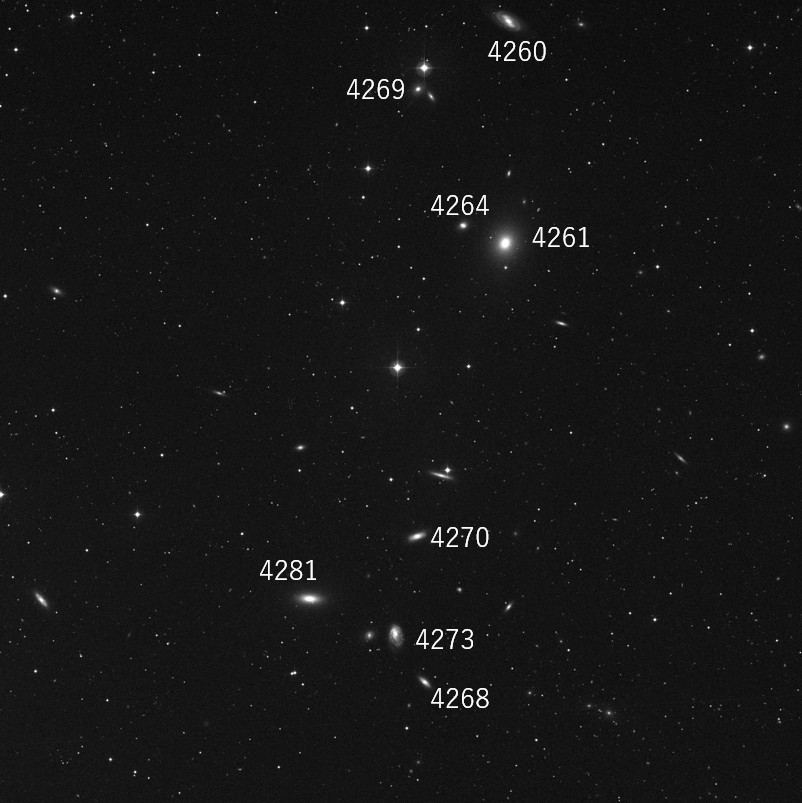
Galaxies around NGC4261. Galaxies checked during this session were marked
with NGC numbers.
The Digitized Sky Survey copyright © 1994
I finished searching session 17 minutes after the beginning of the
twilight, then I enjoyed observing some objects. Pinpoint star image was
wonderful for M35 and M37. The shadow of Io casted on Jupiter. In addition
to that, the color of Io was yellowish and different from the other four
major satellites.
Finally, there are many fine days. I would like to not only sweep the sky
but also observe various kinds of objects. However, my time and energy are
limited. I give top priority to continue sweeping the sky steadily without
being greedy.
Sunday, October 26
In October, we had consecutive days with air temperature over 30ĀčC,
and finally, there appeared some days with temperature lower than 30ĀčC for
this one week. Still, nasty weather has continued and as a result, so far,
the only day I comet hunted was Saturday 18 at predawn. Even though there
are two comets brightening, C/2025 R2 SWAN and C/2025 A6 Lemon, it was
challenging to observe them.
At dusk on Thursday 18, it was expected clear skies and I headed to the
northern outer rim of Aso with an altitude of 840 m above sea level to
observe C/2025 R2 SWAN. There was no dark night period because the moon
rise was at 18:55 local time and the end of twilight at 19:12. I needed to
observe the comet located at low altitude of the sky for a short period of
time around 19:00. Fortunately, the sky was clear and I was able to
observe the comet. I did not measure the brightness but I intuitively
estimated it as 7th magnitude.

|

|
C/2025 R2 SWAN, Oct. 9 18:47-19:14 JST (9.408-9.426 UT), 46
cm Ethos 21 mm, 97x
After that, days with bad weather persisted. At predawn on Saturday 18, it
cleared up and I conducted a comet hunting session at 3:35am that was the
first time since July. I used Ethos 21 mm 97x, and started with Regulus, ÉŅ
Leonid. In the region there are numerous galaxies with the magnitude of
11th to 12th, but most of them were unidentified due to crescent moonlight
and haze. The first galaxy I noticed in the FOV was NGC2903 (9th
magnitude). The spiral structure was visible because it positioned
relatively high altitude of 34Āč. Strangely, M95, 96 and 105 were missed,
while identified NGC3377, two pairs of galaxies (3227 and 3226, and 3185
and 3190) in addition to 3301. After that, I observed C/2025 A6 Lemon at
4:35am local time.
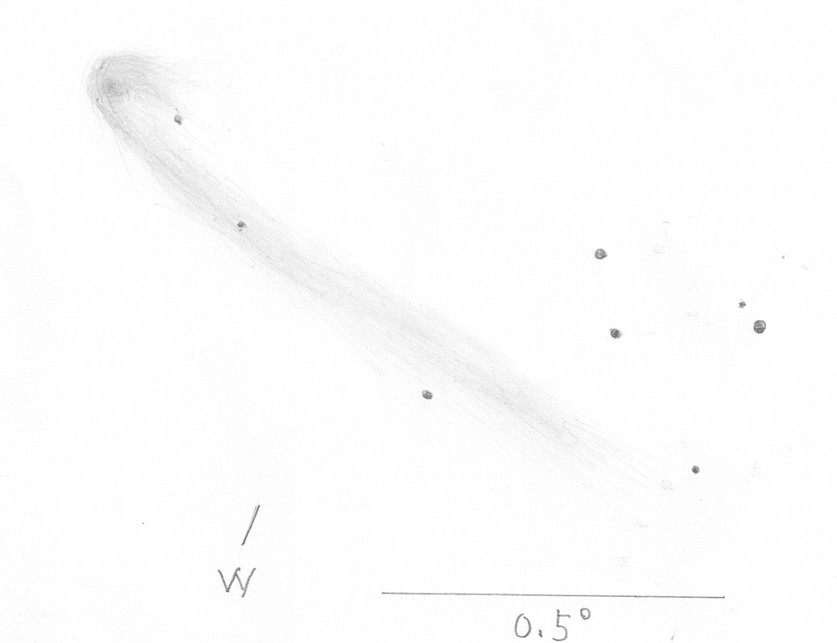
|
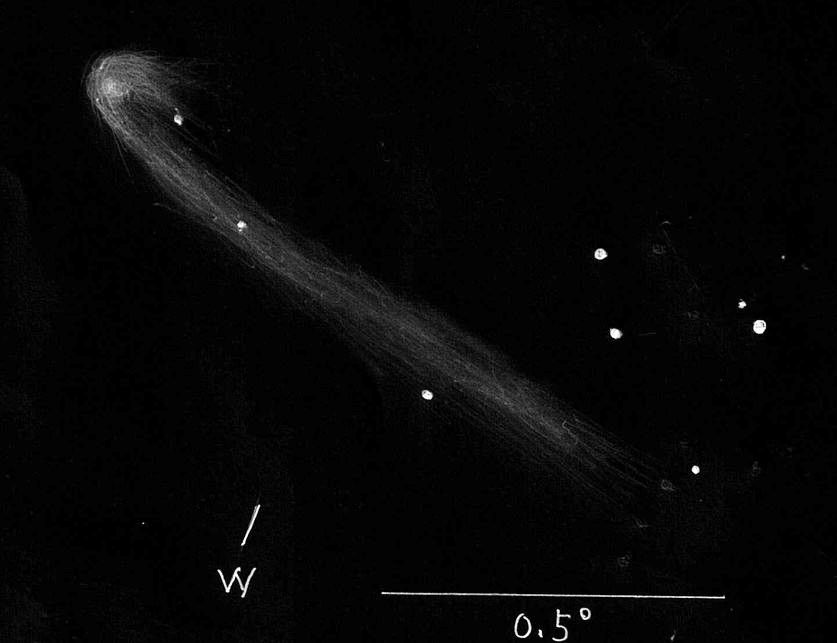
|
C/2025 A6 Lemon, Oct. 18 4:30-4:55 JST (17.125-17.830 UT), 46 cm Ethos 21
mm, 97x
I have no idea why I missed Messier objects, but if there had been a new
comet at the position, I would have been frustrating. However, that is
what fate is all about.
Sunday, September 28
I could not conduct comet hunting for over two months due to prolonged
bad weather. I checked the last day of comet hunting session by turning my
diary, and found the date was 30 July. I started comet hunting in earnest
in 1996, and I think this is the longest record that I was forced to
suspend searching.
To change the subject, early this month, the news of the passing Mr.
Yasushi Oobuchi was circulated on the mailing list of the organizing
committee of the Annual Comet Conference by Junichi Watanabe, Vice
President of the International Astronomical Union, Senior Professor at the
National Astronomical Observatory of Japan. I do not think many people
know OobuchĀfs name.
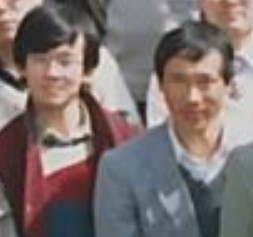
Osamu Abe (right) and author (left). Oobuchi is not in this group photo.
From group photo of the 15th Annual Comet Conference at Sendai
Observatory, 1985: in Annual Comet Conference 50th Anniversary
Commemorative Publication (in Japanese) https://drive.google.com/file/d/15KT3Rz08TGhmj-7FR-hrzd4MbFAZ6qzj/viewĀ@
I had a dream to discover a new comet and searched in my boyhood in the
late 1970s. After I entered a college, I almost stopped astronomical
activities mainly due to light pollution. However, an event led me to
participate in the 15th Annual Comet Conference held at Sendai Observatory
in 1985. At the conference, a comet discoverer, Osamu Abe who lived in
Shinjyo, Yamagata, was next to me. I met him for the first time at the
conference. Yasushi Oobuchi was near Abe. Oobuchi was a person with
disabilities due to muscular dystrophy, an intractable disease. He was in
a wheel chair and his arms and head moved constantly due to involuntarily
movements. Under such a serious circumstance, he said that he conducted
comet hunting. Hearing this I could not help but strongly wished ĀgI truly
hope this person discover a cometĀh.
Abe supported Oobuchi in various ways, and said that while Mr. Oobuchi
worked hard, we able-bodied must not be careless. Even now, the words are
etched into my mind.
Time passed and it was July 2017 when Maik Meyer in Germany https://www.comethunter.de/me.html
sent me an email. He read an article on my web page, entitled ĀgUnconfirmed
cometĀh. I wrote that I discovered the comet like object but the next day
no one including me could not confirm it, and that ĀgA certain Japanese
comet hunter told me a similar story. http://comet.la.coocan.jp/discovery/Unconfirmed/Unconfirmed_comet.htmlĀ@
He asked me to get information from the comet hunter. The comet hunter was
Oobuchi. Oobuchi told me that he spotted a comet like object during his
hunting session, but the object moved rapidly in the field of view and he
could not determine the position.
I emailed Osamu Abe and asked him to contact Oobuchi. Abe replied that he
lost contact with him after the last letter in September 1996. Abe sent a
letter to Oobuchi but there was no reply after one month. Abe thought that
OobuchiĀfs family received the letter but he was unable to reply. Abe said,
unfortunately, there was no choice but give up.
Maik Meyer coauthored a book with Gary W. Kronk entitled ĀhCatalog of
Unconfirmed Comets - Volume 2: 1900 to the Present (Historical &
Cultural Astronomy)Āh https://link.springer.com/book/10.1007/978-3-031-56691-2
If I had contacted Oobuchi and heard the story on the comet, his discovery
story would have been published in the book.
https://www.amazon.com/Catalog-Unconfirmed-Comets-Historical-Astronomy-ebook/dp/B0CZ8P7VWCĀ@
Open the above site and select (below the cover) ĀgRead sampleĀh > (upper
left) ĀgAvailable sampleĀh >ĀhpaperbackĀh, and then down to page 409. Index
is shown from the page. Many Japanese including who assisted its editing
the book appear. One can find ĀgHonda, M. (Minoru Honda), Seki, T. (Tsutomu
Seki), Tomita, K. (Kouichiro Tomita)Āc It is deeply regrettable that
OobuchiĀfs name was not included here.
Sunday, August 31
Once again, this month bad weather hindered comet hunting.
While I was thinking on comets, suddenly, I remembered a book entitled
ĀgComets and LifeĀh by Fred Hoyle, Chandra Wickramasinghe and Shin
Yabushita, 1980. I was very impressed to it when I was a college student.
It refers to comets in general in the first half, while in the second half
it describes life in relation to comets and is interesting. The book is
coauthored by Hoyle and Wickramasinghe, but they just contribute to
Introduction.

Yabushita predicted that amino acids, materials for protein, exists in
interstellar space and comets. However, it also describes that Āgit is
challenging to detect amino acids using a radio telescope, even if the
simplest form of it, i.e. glycineĀh.
In 2009 glycine was detected from a sample collected by Stardust
spacecraft from 81P Wild 2 that was returned to the earth. Glycine was
also found in a sample from 67P Churyumov-Gerasimenko in 2016.
Amino acids had already been detected from Murchison meteorite fell in
1969 in Australia, but the detection from comets is of great significance.
Yabushita studied abroad at Cambridge University and supported a bold
hypothesis advocated by Hoyle and Wickramasinghe, Panspermia, which is
briefly described in the book. It claims that life is born in comets and
falls to the earth. Additionally, virus or bacteria for epidemic diseases
like influenza and smallpox are spread from comets. It also states that
the evolution of life occurs through new genomes introduced such
processes. The hypothesis is compelling and there is nothing unnatural if
one regards that the earth as non-closed system and that there is always
interaction between it and the space.
There is a hypothesis that Yabushita proposed and it turned to be true.
The cause of the mass extinction of life at the end of the Cretaceous
period is considered as a celestial collision. However, many scientists
think it alone is insufficient. Yabushita thought the solar systemĀfs
passage through a giant molecular cloud is the cause of mass extinction.
In 2016 Japanese scientists showed that such passage reduced solar
radiation for 8 million years at the end of the Cretaceous period that led
to global cooling, one of the causes of the mass extinction. https://doi.org/10.1016/j.gr.2015.12.004
Although the results of the study are different from the process Yabushita
assumed, his hypothesis is partly correct at least.
I think the day when life is detected in satellites in solar system or
comets is not far off. Panspermia theory being heretical at the era when
the book was published become astrobiology, a major scientific field at
present. Long has been passed since many said that the era when amateursĀf
comet hunting has finished, but this Āgconventional theoryĀh has yet
overturned.
Wednesday, July 30
I was infected with COVID-19 and was in bed for about a week. Finally,
my fever subsided and returned to my work yesterday, For this reason, I
will be taking a break from writing my diary.
Sunday, June 29
I could not comet hunt at all in June, because we had no clear sky. I
looked into the record on my comet hunting for a decade and found that I
comet hunted at least once in June, and on average, I did 1.9 times. There
were few clear sky in May also, and I must say the climate is abnormal.
Comet discoveries by amateurs have been threatened by robotic survey,
which discovered a host of comets, since the latter half of the 1990s.
Later this year, finally, a telescope that exceeds the capabilities of the
previous robotic surveys will be operated. The 8.4 m Simonyi Survey
Telescope at the top of Mt. Cerro Pachón in Chile in Vera C. Rubin
Observatory equipped with the world largest CCD camera, 3.2 billion
pixels, has the 3.5Āč field of view (9.6 square degrees). It can survey all
the sky during three to four nights. Pan STRRS in Hawaii consists of a
pair of 1.8m telescopes with CCDs of 1.4 billion pixels covering 7 square
degrees. However, Simonyi Survey Telescope in Vera C. Rubin Observatory is
much more powerful than Pan STTRS. It is surprising that the telescope
newly discovered 2104 asteroids during only around 10 hours of test
observations.
https://rubinobservatory.org/news/rubin-first-look/swarm-asteroids
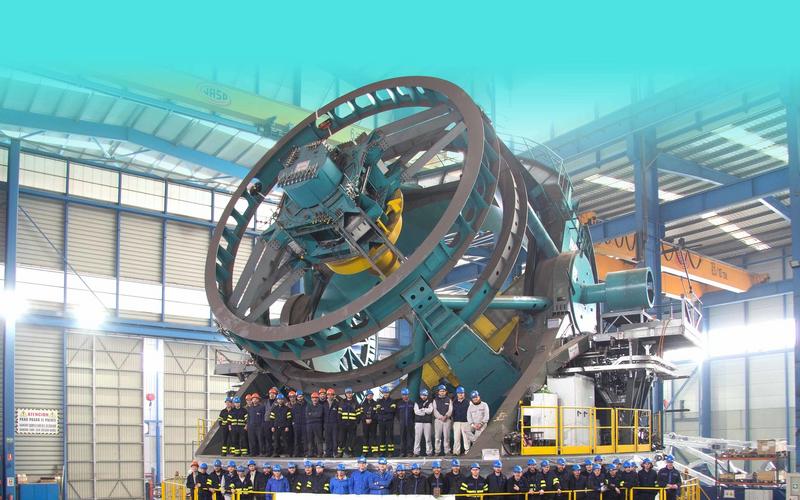
Completed telescope mount assembly
Credit: Asturfeito
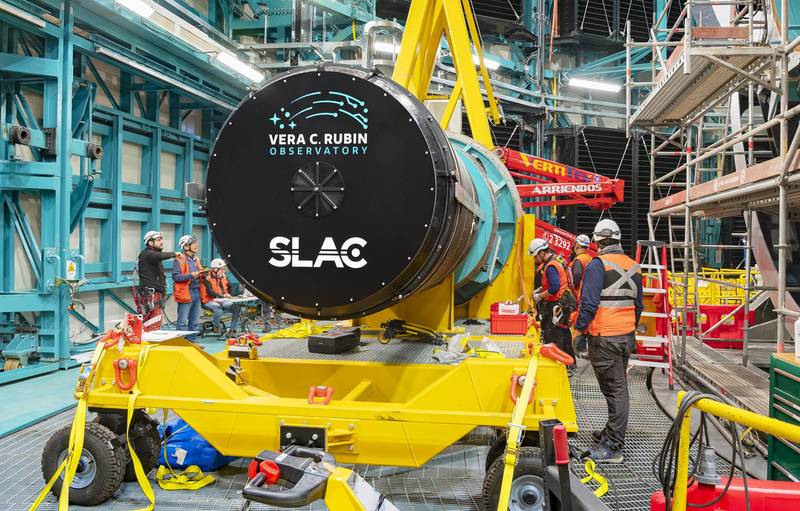
Installing CCD camera with 3.2 billion pixels
Credit: RubinObs/NOIRLab/SLAC/NSF/DOE/AURA/B. Quint
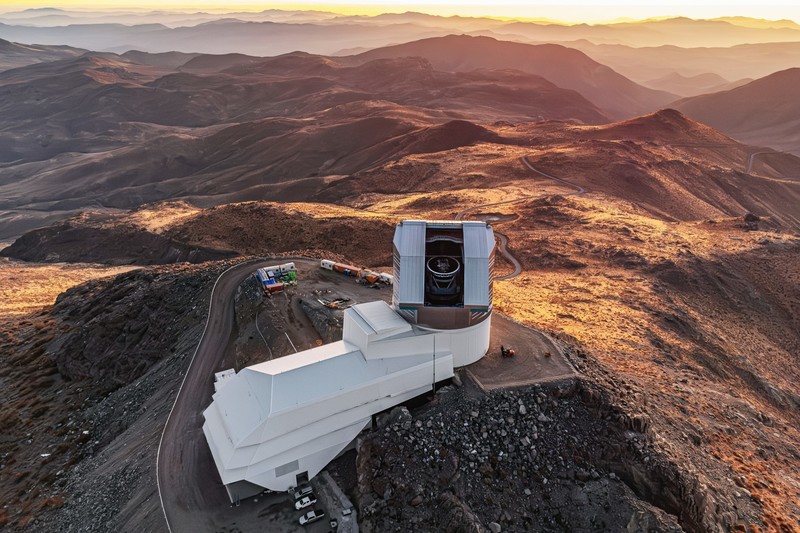
A drone view of Observatory
Credit: RubinObs/NOIRLab/SLAC/NSF/DOE/AURA/T. Matsopoulos
The observatory was once called LSST (Large Synoptic Survey Telescope). In
2020 the American Astronomical Society renamed the name after Vera C.
Rubin, American astronomer.
The observatory will continue a survey for 10 years. Although it is
located at the latitude of 30Āč south and does not cover the part of the
northern sky, it is expected that the telescope can detect dark comets
very far from the sun. It will become much harder for amateurs to discover
new heavenly bodies, including novae, supernovae and comets. Nonetheless,
it is difficult for robotic surveys to discover a comet that approaches
the earth from behind the sun. I do not think that it is impossible to
discover a new comet by amateurs at all. Off course, visual discoveries
will not completely impossible.
Saturday, May 31
I conducted comet hunting sessions only twice in this month, Thursday,
Mayb 8 and today, Saturday, May 31. I got up several days at predawn
around 4 hours before the sunrise (2 and a half hours before the start of
the twilight) at the beginning of this month, trusting the forecast for
clear skies. However, the forecast was often wrong and cloudy. I look back
the sessions on Thursday, May 8 and today.
Thursday, May 8
Arriving at the site at 2:06am local time. The clouds covered the sky with
the altitude of 20Āč and less. Before the comet hunting session, I observed
M13, M20, M8, M57 and M17 using Ethos 13 mm, 157x. Thanks to excellent
seeing and a good transparency, the microstructures of M17 and M27 were
visible, as if I have looked at the photos or observing them using Night
Vison. The central star of M57 could be seen constantly.

The microstructures of bright part of M17 (the swan-shaped part, the sawn
is upside-down in the photo) and the shape of darker part were clearly
visible. The image is 60Āf square.
The Digitized Sky Survey copyright © 1994
The area where the clouds covered decreased down to the altitude of 10Āč
and less, when I started the hunting session from M2 at 3:05am local time.
I finished the session at 4:20am and I identified no deep sky objects
(DSO) during the period, because there are few bright DSO in the area.
I observed Saturn with disappearance of the ring after the comet hunting
session. It was true that there was no ring, but I noticed extremely thin
shadow of the ring shed on the body of the planet. We are looking at the
ring of Saturn (equatorial plane) head-on from the earth, while from the
sun it is not head-on that means a plane including the ring receives
sunlight. That is the reason for the shadow casted.
Although I encountered no DSO during the session, I had a great time
observing DSOs and Saturn thanks to wonderful sky condition.
Saturday, May 31
The sky was clear with wind, but I did not feel chilly as the air
temperature was 10ĀčC. Seeing was quite poor and transparency also poor.
The light pollution was boosted by aerosols impairing transparency (the
specific substance is unknown). The light sources not only from two major
cities, Kumamoto (40 km away from the site with a population of 730,000)
and Oita (60 km, 470,000), but also from smaller cities, Nobeoka (55 km,
110,000) and Hyuga (60 km, 55,000) deteriorated the situation. I checked
the limiting magnitude of the naked eye star using stars in Lyra nearly at
the culmination prior to the comet hunting session. I definitely confirmed
the 6th magnitude stars with an averted vision, although visibility was
unstable due to poor seeing. The darkest star observed was the magnitude
of 6.7, HD 176133 (TYC 2651 641). The area near the zenith is less
susceptible to light pollution.

Location of observation site and major surrounding cities.
Drawn based on https://supercweather.com/
White and blue parts represent clouds at 3:00am local time on May 31,
2025.
Then, I trained my telescope at some DSOs as I did on May 8, however,
visibility was unsatisfactorily because of poor sky condition. I could
observe the central star in M57 only for a moment during some 2 minutes of
observation. I aimed the telescope at Albireo rising at an altitude of
nearly 80Āč above the horizon. It shined with a wonderful transparency like
a clear gemstone. Albireo was the only impressive object in a series of
the observation.
I began to comet hunt using a combination of Planokular 30 mm and Paracorr
with 87x instead of Ethos 21 mm 97x due to poor seeing. The star image
swells with 97x and I cannot concentrate on peering the field of view. The
objects identified were two 11th galaxies in the constellation of Pegasus,
NGC7743 and 7742 only. I changed the eyepiece to Ethos 21 mm during the
session because seeing became better gradually. That makes the contrast
higher and easy to detect a comet.
After the session, I observed Saturn. Thin ring that was not seen on May 8
was clearly observed.
Feeling wind, air temperature, humidity and aerosols, that is to say
earthĀfs atmosphere directly on your skin, one observes motions and changes
in the celestial bodies. I sense some religious significance in this.
Sunday, April 13
Bright comet, C/2025 F2 SWAN, was discovered from SWAN images of the
Solar and Heliospheric Observatory (SOHO). I observed this comet for the
first time at predawn on Monday, April 7 JST. The comet was 8th magnitude,
5Āf in diameter, tail length of 7Āf and 3 in degree of concentration (DC) at
4:03 JST when the altitude was 5Āč above the horizon, while 8th magnitude,
6Āf in diameter, 15Āf in length and 3 in DC at 4:20 JST with the altitude of
9Āč. Those values were estimated by intuition not formal using 46 cm 97x
with Ethos 21 mm, and I did not report to any institutions like COBS. The
comet is expected to reach 4th magnitude, and it already has a wonderful
tail.
There has been active exchange in information on the comet via comets-ml before the ground-based observation was
made. First of all, Michael Mattiazzo, Australia, wrote ĀgThere is a
pretty obvious comet visible in SWAN comet tracker mapsĀh, and he requested
to confirm at April 1.517 UT. Mattiazzo said it was visible on March 23
and the magnitude was 11+. Some tried to confirm the object both visually
and photographically, but reports were negative. Qicheng Zhang, US, succeeded to observe the comet using
40 mm refractor as R magnitude of 12th on April 02.51, however, the
position was 2.5Āč off from the orbital elements calculated by Rob Matson. Michael Jäger, Austria, observed the comet on April
03.13479 UT photographically, with the magnitude of 9 to 10.
According to CBET the comet was reported by Vladimir Bezugly
(Dnipro, Ukraine) on March 29, followed by Michael Mattiazzo (Swan Hill,
Vic., Australia) on the same day, and Rob D. Matson (Irvine, CA, USA) on
March 31. Bezugly is a person who revealed that the fast-moving comet-like object I detected last year
as potentially a Chinese satellite spewing fuel. He discovered SWAN
comet in the past.

Positions of C/2025 F2 SWAN. A: Predicted position based on the orbital
elements calculated on April 2, 2025, by Horohisa Sato. B: Calculated on
April 6, 2025. B is 2.9Āč west of A. Produced using Guide 9.
I tried observing C/2025 F2 on April 2.82 UT based on the orbit calculated
by Hirohisa Sato that did not include data of Qicheng Zhang, but failed.
On the next day, April 3.82 UT, I could not again. The cause I could not
spot it was, firstly, tried to observe during the session and searched
only Ā}1Āč of the predicted position, secondly, the ephemeris included 2.9Āč
of error (it was reasonable considering calculation based on SWAN images),
and lastly, I received huge amount of emails from comets-ml and did not
read one from Michael Jäger received on April 3.18 UT that included the
positions he measured.
I did not regret very much that I failed to confirm the comet, because I
am a comet hunter not an observer. Nonetheless, it is a little
embarrassing if I had spent several minutes more to search wider area, I
would have been the second observer of the comet from the ground in the
world next to Qicheng Zhang.
As described in CBET, Guoyou Sun, Xingming Observatory, China, found
the comet was in CCD image taken by 0.11-m f/3.6 refractor on March 26.93
UT. The coma was 30Āh and V magnitude of 14.0 to 14.4 without a tail.
Mattiazzo estimated from SWAN images that the magnitude was 11th, and the
discrepancy from the observation at Xingming Observatory was very large. A
comet hunter Tetsuo Kudo, Kumamoto, said on March 31 the comet was only
recognized as a haze on the photos, while on April 4 it was 10th
magnitude. Those observations indicate that the comet was bright from the
beginning on SWAN images but that it was dark from the ground-based
observation. I think one of the reasons that initially the comet was
undetectable from the ground, i.e. visible to infrared, was the darkness
in comparison with SWAN images, ultraviolet.
Takaaki Oribe, Saji Observatory, Tottori, observed the spectrum of C/2025
F2. Oribe showed the comet is gas-rich and less dust. I think the comet
looks dark using Night Vision (NV), because NV is less sensitive to
gas-rich comets, although, unfortunately, I could not observe C/2025 F2
using NV, since my NV is out of order and under repair.
As for C/2025 F2, it was almost impossible to discover either visually or
photographically from the ground before the discovery from SWAN images.
Sunday, March 30
I look back my comet hunting session in February and March. I did it
five times in each month. In the February sessions, I used Night Vision
(NV) twice and Ethos 21 mm three times, while in the March sessions, NV
three times and Ethos twice. NV was employed only nights with moonlight.
Having said so, I sometimes use NV under poor transparency. These days, I
use both eyepieces depending on the sky conditions.
C/2023 A3 Tsuchinshan-ATLS, which was bright and long-tailed comet on the
western sky at dusk last year, rose on the eastern sky at predawn before I
knew it. I noticed this comet was on the east at predawn after the comet
hunting session one day at the end of February. Just at the moment, I had
an opportunity to contact Hideo Nishimura, a comet discoverer. He said he
could not observe the object, because clouds continued to appear on the
eastern sky every time he tried to observe.
On the other hand, it had been cloudy and rainy at my observing site, and
finally, I had a chance of observation on Friday, March 7 local time. The
comet was estimated as12th magnitude, apparent diameter of 1Āf with a tail,
using 46 cm reflector Ethos 21 mm 97x. The visual data obtained with Ethos
21 mm was the same as NV & Paracorr, 37x, but the object was easier to
detect using NV. I thought the comet was discoverable during the comet
hunting session using each eyepiece, although it was difficult.
On Sunday, March 9 local time, using Ethos 21 mm, the comet fated to 13th
magnitude, apparent diameter of 0.2Āf, degree of concentration (DC) 2, and
I managed to noticed it. With NV the magnitude was 13th, 0.1Āf in diameter,
DC 8. It looked almost stellar but the existence was obvious. I observed
the comet at around 4:15am local time with the altitude of only 17Āč above
the horizon. After that, I took the break during the session and trained
my 46 cm reflector at C/2023 A3 at 5:13am local time when the comet rose
29Āč above the horizon. However, there was no difference in appearance.
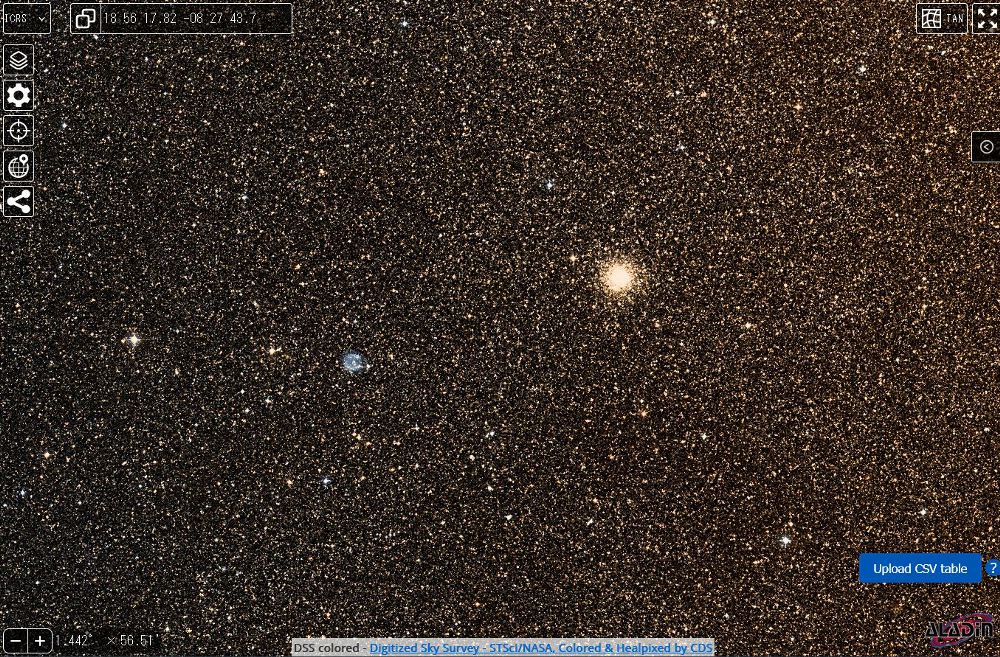
IC1295, planetary nebula (left) and NGC6712, globular cluster (right). The
image is 1.44Āč wide.
https://aladin.cds.unistra.fr/AladinLite/
All deep sky objects identified during the session on Sunday, March 9,
were N26, NGC6712, IC1295, M11, and M75. Among those, this was the second
time in nine years I observed IC1295. The object is a planetary nebula
seen in the same field of view with NGC6712, a globular cluster. I
observed it for the first time at 3:02am
on May 18, 2016, at the site in Niigata Prefecture with the altitude
of 950 m with the air temperature of 5ĀčC, and the object was 44Āč above the
horizon. Although by the time, I observed NGC6712 tens of times, I had
never noticed a comet-like object in the vicinity of the cluster, and in a
moment, I doubted it as a new comet. Nonetheless, unfortunately, the
object was on the atlas. Since then, I tried observing the nebula and
aimed my telescope, but I have never succeeded. Although the conditions of
this time, IC1295 being 29Āč above the horizon, air temperature of 0ĀčC, the
altitude of the site 850 m, were nothing special, I could finally
encounter this planetary nebula again thanks to good transparency.
Whether the object of interest is visible or not is dependent on the
atmospheric conditions at the time, and even if one can see it, the way it
looks greatly different. On top of that, the impression of the object one
observes changes depending on oneĀfs state of mind at the time. Discovery
of a comet is also dependent on atmospheric conditions and mental state.
Sunday, February 9
It had been cloudy and snowy due to strong cold wave, but finally, we
had a stable clear sky. This was the first comet hunting session in
February. It was clear sky and windless with the air temperature of -10ĀčC.
The record low throughout my comet hunting history circa three decades!
Having said so, I felt chillier when temperature is plus a few degrees
with strong wind.
Shogo Utsunomiya, a comet hunter living in Mimami-oguni, Kumamoto, told me
that an air temperature reaches -15ĀčC at his observatory. He said he
bought a down jacket but he had never worn it, because the walls of his
observatory protect him from winds and kept warm.
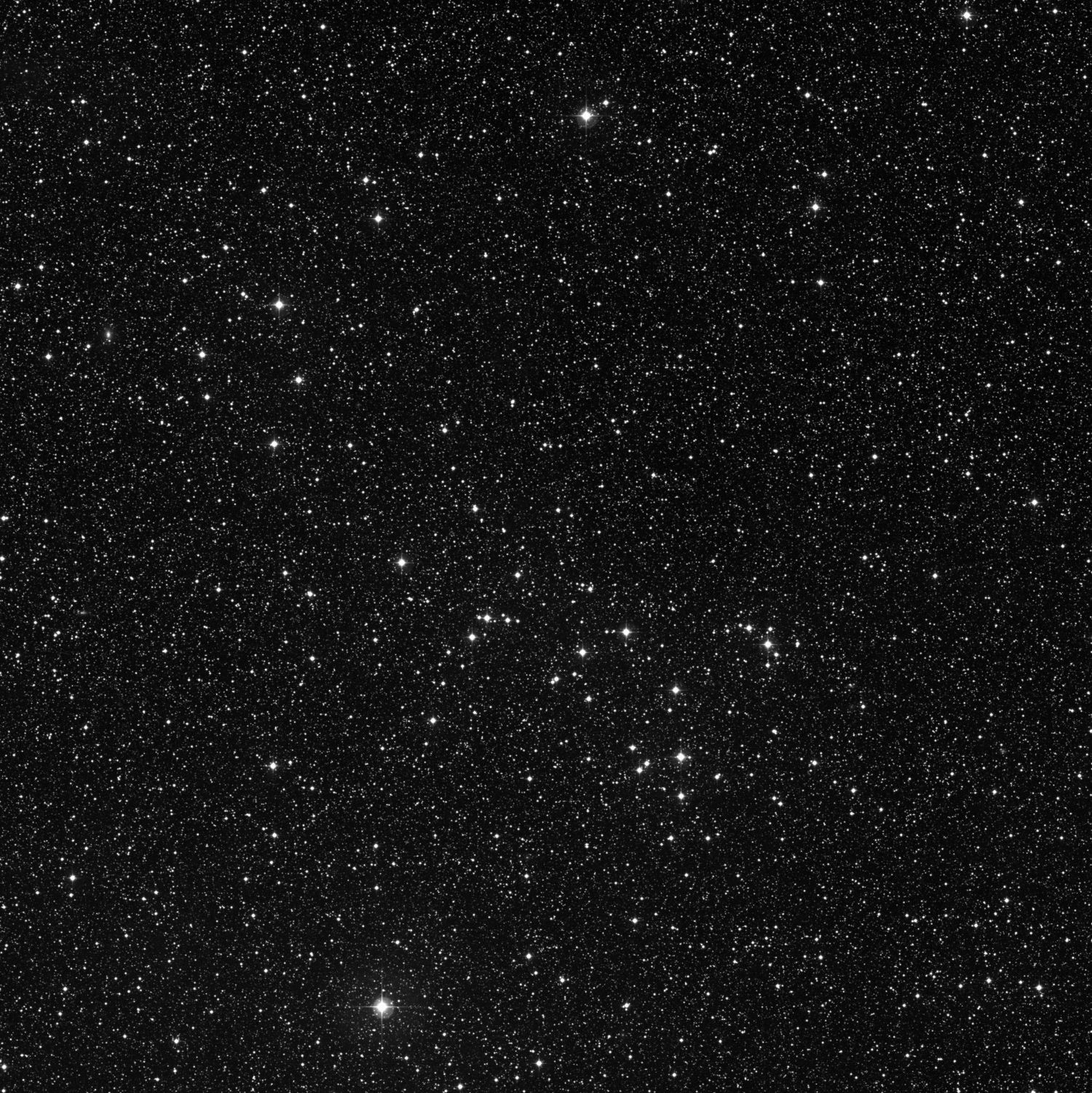
NGC6633, an open cluster in the constellation of Ophiuchus. The image is
60Āf wide.
The Digitized Sky Survey copyright © 1994
I often searched along the ecliptic mainly Scorpius and the western part
of Sagittarius last month. There are many open clusters and spent a lot of
time to identify. This time, I began with M14, a globular cluster in
Ophiuchus, more northernly the region, using a glass eyepiece (Ethos 21
mm, 97x). Although there are less globular clusters in the area, many
stars shine in the FOV as it overlaps with the summer Milky Way. Numerous
open clusters are sparkling like a blooming flower. The most impressive
open cluster I observed this time was NGC6633.
Generally, the colder the amount of water vapor in the atmosphere
decreases making transparency high, the better the star visibility is.
Today, stars shined beautifully, and the observing site was covered with
pure white snow as Minoru HondaĀfs poem.
May the starlight be purely transparent
The flowers beautiful in spring
Water flow crystal clear in summer
Breezing refreshing in autumn
and
Pure white snow fall in winter
I take a decent measure to protect
against cold during the comet hunting session, and I do not feel
chilly up to the air temperature of -5ĀčC. However, under the temperature
lower than that I feel my fingertips cold. On the other hand, it is
inefficient to use gloves with heater, because it requires more time and
effort for preparation.
The time when I completed the session, Scorpius shines splendidly on the
east. The season when Scorpius rises in the eastern sky at predawn, the
coldness reaches its peak as Tsutomu Seki wrote in his publication.
Sunday, January 12
I went on a comet hunting everyday Wednesday Jan. 1 through Monday Jan. 6
thanks to good weather at the beginning of the month. Among those days,
the forecast predicted clear sky on Thursday, and I drove to the observing
site. However, it was cloudy at the site and there was no expectation to
recover, and I returned back to my home. On Sunday, soon after I started
comet hunting clouds began to cover the sky, and I searched only 20 min in
total.
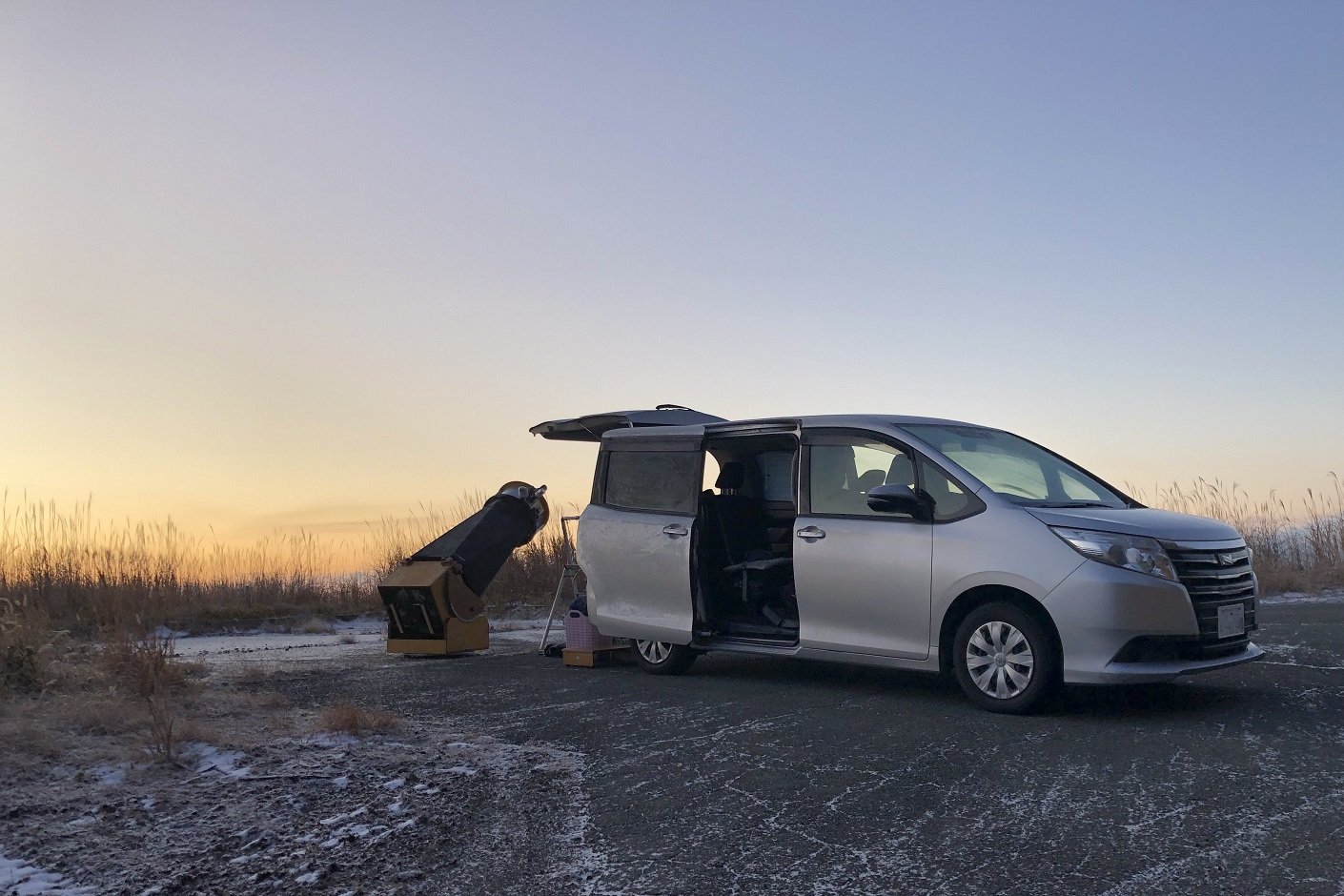
Observation site with slight snow cover. The photo was taken after the
session on Saturday, Jan. 11.
Yesterday, Saturday Jan. 11, it was cloudy around my house, however, the
Super Computer Weather predicted recovery of the weather.
Unexpectedly, soon after I left home for the site, snow started to
flicker. I did not care and drove around 10 min, but snow began to fall in
earnest. I parked my car to confirm the radar image using my smart phone,
but no snow clouds. I headed to the site believing the forecast. At 3:45am
local time, I arrived at the site and it was snowing but I could see some
stars through thin clouds. There was slight snow accumulation there. I
decided to wait for the recovery of the weather.
At 4:15am, it stopped snowing and starry sky began to open up. I set up my
telescope and was ready to observe at 5:00am. In summer I am ready to
observe within 30 min after arrival, but in winter it takes 45 to 50 min:
wearing polar jackets, pants and boots, preparing disposal chemical heater
for my back and toes, slow motion due to low temperature. The thermometer
indicated the air temperature of -8ĀčC. It was windless but the coldest
predawn chill this winter.
When I lived in Niigata Prefecture, I observed at the site with the
altitude of over 900 m above sea level in summer, while 430 m above sea
level in winter because the roads are closed due to snow. The record low
of the air temperature at that time was -8ĀčC. The coldest record during
comet hunting session after moving to Kumamoto was -9ĀčC at the present
observation site with the altitude of 850 m.
On Saturday before the comet hunting session, I observed Omega Centauri
that rose 4Āč above the horizon with Ethos 21 mm, 97x. Although it was
slightly dark because it was still low altitude (9Āč at the meridian), the
cluster contains a great number of stars and impressive enough as the most
beautiful globular cluster in the entire sky.
I started sweeping the sky from ÉŅ Librae, Zubenelgenubi at 5:04am. The
deep sky objects I encountered were NGC5796, 5897, a pair of galaxies 5915
and 5916, M4, M30, M62 and M19. When I spotted NGC5915 (magnitude of
12.3), I identified it referring to SkySsafari 7 Pro, a digital map. On
the map, a darker galaxy, NGC5916 (magnitude of 13.2), was shown in the
south of NGC5915 and I noticed in the FOV.
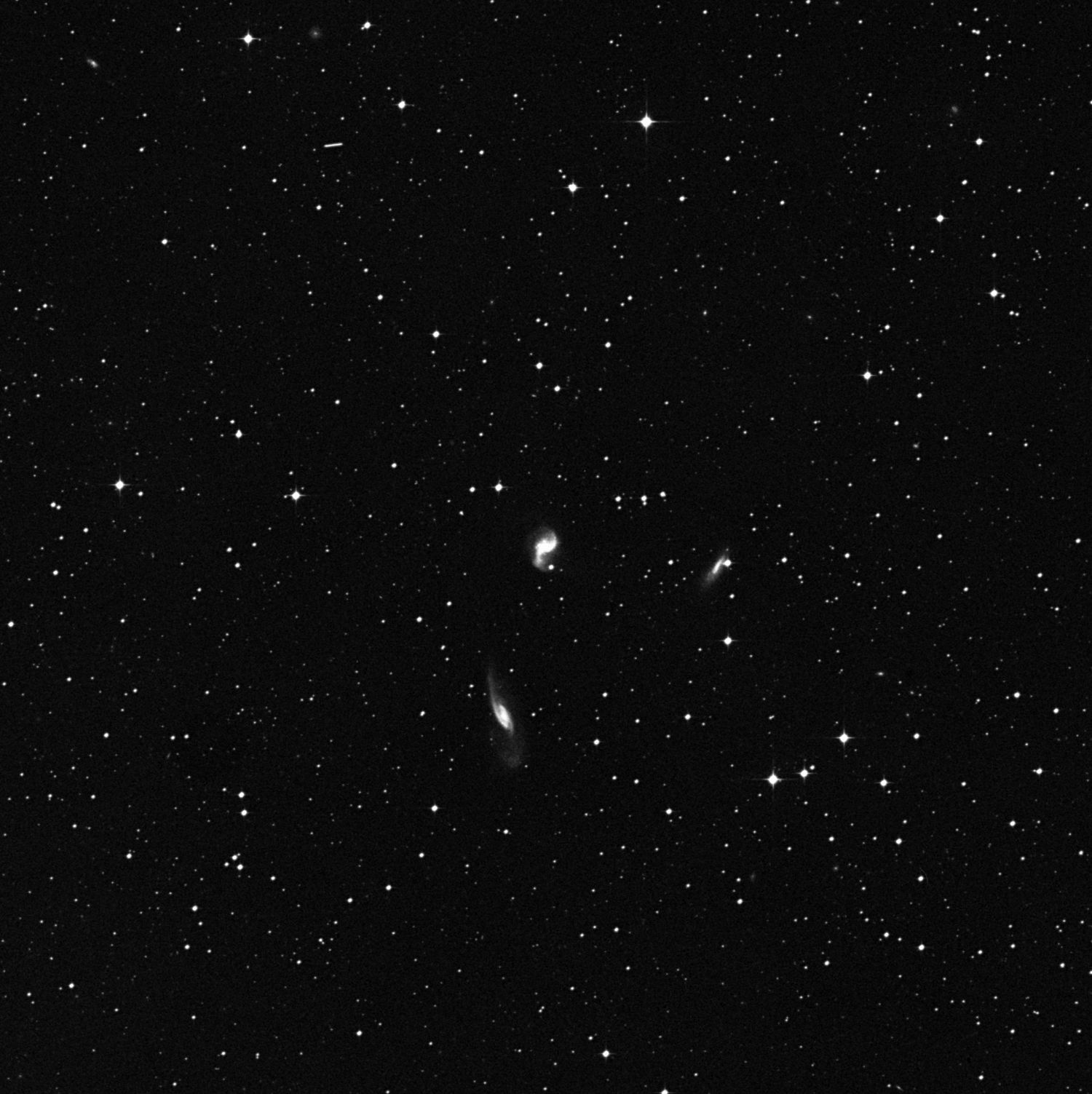
NGC5915 (center) and 5916 (lower center). The image is 30Āf in width
The Digitized Sky Survey copyright © 1994
Double stars looked beautiful since a glass eyepiece was used for the
session instead of Night Vision that produces black and white images. The
most impressive one during the session was Éņ Scorpii. The primary star was
golden and the secondary light blue. The scintillation deformed them and
it looked like they were smiling and dancing.
I stayed at the site after the comet hunting session that ended at 6:21am,
30 min after the start of the twilight, to observe C/2024 G3 ATLAS. The
comet rose at 6:29am, but there were clouds at the low altitude and I
could not observe the comet. The clouds moved slowly, and I continued
observation. At 6:41am, I found the comet with a tail 0.1Āč long using 7x50
mm binocular. The altitude of the object was 1.2Āč. I could not see it with
naked eyes. The comet was visible for a while disappearing in and out of
the clouds. I could not aim the 46 cm telescope at the comet because
grasses at the site hided the comet. While I was taking down my telescope,
the sun rose at the direction where the comet rose. I visited
the site hundreds of times, but this was the first time I saw sunrise
here. It was so refreshing to watch the sunrise after observing the bright
comet.
Top of this page




















